Dative covalent bond - Study guides, Revision notes & Summaries
Looking for the best study guides, study notes and summaries about Dative covalent bond? On this page you'll find 60 study documents about Dative covalent bond.
Page 3 out of 60 results
Sort by
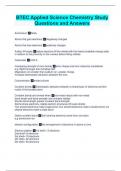
-
BTEC Applied Science Chemistry Study Questions and Answers
- Exam (elaborations) • 4 pages • 2024
-
- £7.96
- + learn more
Ammonium NH4+ Atoms that gain electrons Negatively charged Atoms that lose electrons positively charged Aufbau Principle states electrons fill the orbital with the lowest available energy state in relation to the proximity in the nucleus before filling orbitals Carbonate CO3 2- Comparing strength of ionic bonds Ionic charge and ionic radius be considered e.g. MgF2 stronger than bonding NaF Magnesion ion smaller than sodium ion- greater charge Increase electrostatic attractio...

-
Chemistry- Acids, Bases, and Buffers questions and answers graded A+
- Exam (elaborations) • 9 pages • 2023
- Available in package deal
-
- £11.95
- + learn more
Chemistry- Acids, Bases, and Buffers Define Acid - correct answer A proton donor. Define Base - correct answer A proton acceptor. Why is H+ a Proton - correct answer Because hydrogen is just one proton and one electron. Take away the electron and you're left with H+. Define Alkali - correct answer A type of base which dissolves in water to form OH- ions (a soluble base). What is a Monobasic Acid and Give an Example of One - correct answer A monobasic acid e.g. HCl is an acid which ...
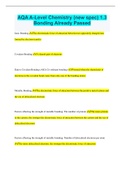
-
AQA A-Level Chemistry (new spec) 1.3 Bonding Already Passed
- Exam (elaborations) • 10 pages • 2023
- Available in package deal
-
- £7.96
- + learn more
AQA A-Level Chemistry (new spec) 1.3 Bonding Already Passed Ionic Bonding The electrostatic force of attraction between two oppositely charged ions formed by electron transfer Covalent Bonding A shared pair of electrons Dative Covalent Bonding (AKA Co-ordinate bonding) Formed when the shared pair of electrons in the covalent bond come from only one of the bonding atoms. Metallic Bonding The electrostatic force of attraction between the positive metal cations and the sea of delocalised electro...
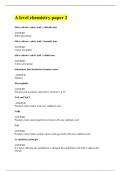
-
A level chemistry paper 2
- Exam (elaborations) • 8 pages • 2024
-
- £8.35
- + learn more
Silver nitrate+ nitric acid + chloride ions ANSWER White precipitate Silver nitrate+ nitric acid + bromide ions ANSWER Cream precipitate Silver nitrate+ nitric acid + iodide ions ANSWER Yellow precipitate Substances that decolorise bromine water ANSWER Alkenes Electrophiles ANSWER Electron pair acceptors, attracted to electrons e.g H+ NaF and NaCl ANSWER Produces misty fumes with conc sulphuric acid NaBr ANSWER Produces misty and orange/brown ...
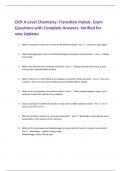
-
OCR A Level Chemistry: Transition metals. Exam Questions with Complete Answers. Verified for new Updates
- Exam (elaborations) • 5 pages • 2024
- Available in package deal
-
- £4.37
- + learn more
1. Which 2 transition metals do not have a fully filled 4s orbital? - Ans .Chromium and copper 2. What advantage does a fully or half filled shell give a transition metal and why? - Ans .Makes more stable 3. What is the definition of a transition element? - Ans .D-block element which form at least one ion with a partially filled d orbital 4. Which 2 elements in the d block do not qualify as transition metals and why? - Ans .Zinc and scandium. Their ions have full d orbitals and not part...
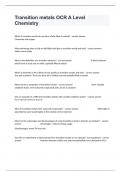
-
Transition metals OCR A Level Chemistry Comprehensive Exam With Questions & Correct 100% Verified Answers
- Exam (elaborations) • 5 pages • 2024
- Available in package deal
-
- £10.35
- + learn more
Which 2 transition metals do not have a fully filled 4s orbital? - correct answer Chromium and copper What advantage does a fully or half filled shell give a transition metal and why? - correct answer Makes more stable What is the definition of a transition element? - correct answer D-block element which form at least one ion with a partially filled d orbital Which 2 elements i...
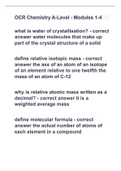
-
OCR Chemistry A-Level - Modules 1-4 with 100% correct answers
- Exam (elaborations) • 25 pages • 2023
- Available in package deal
-
- £9.55
- + learn more
what is water of crystallisation? water molecules that make up part of the crystal structure of a solid define relative isotopic mass the ass of an atom of an isotope of an element relative to one twelfth the mass of an atom of C-12 00:03 01:39 why is relative atomic mass written as a decimal? it is a weighted average mass define molecular formula the actual number of atoms of each element in a compound define what an orbital is a region within an atom ...
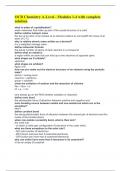
-
OCR Chemistry A-Level - Modules 1-4 with complete solution
- Exam (elaborations) • 6 pages • 2023
-
- £9.16
- + learn more
OCR Chemistry A-Level - Modules 1-4 with complete solution what is water of crystallisation? water molecules that make up part of the crystal structure of a solid define relative isotopic mass the ass of an atom of an isotope of an element relative to one twelfth the mass of an atom of C-12 why is relative atomic mass written as a decimal? it is a weighted average mass define molecular formula the actual number of atoms of each element in a compound define what an orbital is a region...
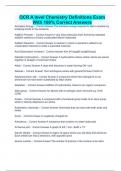
-
OCR A level Chemistry Definitions Exam With 100% Correct Answers
- Exam (elaborations) • 10 pages • 2024
-
- £9.08
- + learn more
OCR A level Chemistry Definitions Exam With 100% Correct Answers Activation Energy - Correct Answer The minimum energy required to start a reaction by breaking bonds in the reactants Addition Polymer - Correct Answer A very long molecular chain formed by repeated addition reactions of many unsaturated alkene molecules Addition Reaction - Correct Answer A reaction in which a reactant is added to an unsaturated molecule to make a saturated molecule Acid Dissociation Constant - Corre...
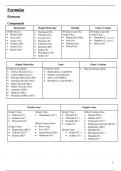
-
AQA AS Level Physical Chemistry - Unit 3.1.3 - Bonding - Full Notes
- Summary • 9 pages • 2023
- Available in package deal
-
- £2.99
- + learn more
Detailed notes for AQA AS level chemistry unit 3.1.3 (bonding). Covers: ionic bonding, metallic bonding, covalent bonding, dative covalent bonding, polarity, electronegativity, trends in electronegativity, bond polarisation, VSEPR theory, shapes of molecules and intermolecular forces. Includes diagrams and tips on exam technique (with techniques for comparing melting points of molecules).

Do you wonder why so many students wear nice clothes, have money to spare and enjoy tons of free time? Well, they sell on Stuvia! Imagine your study notes being downloaded a dozen times for £15 each. Every. Single. Day. Discover all about earning on Stuvia


